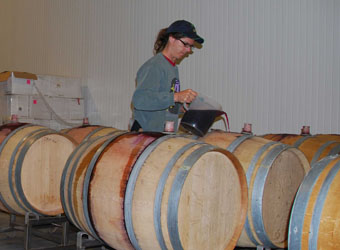
Wine barrel testing
My barrels are American oak, repeatedly used for wine, and about five years old. When empty, I fill them with water containing a strong solution of potassium metabisulfite (one pound to 50 gallons). I find that when the water solution is a little low, and prior to topping with more solution, a burning sulfur stick will extinguish when inserted into the air space. Is this a sure way of determining that the barrel is infected, or is there something else that would extinguish the burning sulfur stick?
John Neild
Cambridge, Maryland
First off, one should never burn a sulfur wick in a wet barrel; only do this (which releases the antimicrobial SO2 gas, which we want) when your barrel is well dried-out. This is because the sulfur gas will combine with the water in the wet barrel and form sulfurous acid, which can lead to a bad taste in the wine. That being said, in any container, the only thing I can think of that would extinguish a burning sulfur stick would be the following: lack of oxygen in the atmosphere in which it’s burning, or a wet or defective sulfur stick. If I’m understanding your letter correctly, you’re telling me that when you lowered a burning sulfur stick into the headspace of your barrel, the stick went out. If it was due to a lack of oxygen, that’s actually a good thing and not a sign of an infected barrel. It means you’re doing something right with your barrel-storing method; having an oxygen-free environment will help prevent bacteria and yeast from gaining a foothold in your stored cooperage, hopefully enabling years of healthy winemaking to come. However, I’d be cautious if I were you because I’m not 100% sure that your stick went out due to lack of oxygen; it could be that it’s a defective stick or that it’s wet. To see if you really have a lack of oxygen in your barrels, you can try an old Burgundian cellar trick and light a long match and lower it into your barrel or vessel. If the flame goes out, you’ve got an oxygen deficit. Otherwise, your sulfur stick may be too damp to burn or may be defective in some other way.
Storing empty barrels is one of the trickiest things we winemakers do. You can keep on doing what you’re doing with “wet storage.” Many of us have good success with storing our emptied barrels with a solution of acidified sulfur dioxide inside them. I recommend an aqueous solution of 1 g/L of citric acid and 2 g/L of potassium metabisulfite. You can also clean your barrels, drain them, air dry them, turn them bung-up and then gas them with sulfur wicks or sulfur dioxide gas.
Dry ice and must
In preparation for this season’s crush I have been thinking about several different ways of protecting my wine from oxidation. After primary fermentation and MLF the CO2 levels in my primary vats will quickly drop. I was thinking about investing in a small tank of Argon to keep the primary gassed during maceration. I have also heard of people dropping in small pieces of dry ice in the must then covering the tanks after punching the must down. Would you recommend using dry ice on the must?
John Ivica Duich
Chicago, Illinois
Dry ice can be a tremendous help for small-lot winemakers in the grape or must stage. Dry ice is really just frozen carbon dioxide gas and will cool the air (or liquid) where it’s placed whilst releasing carbon dioxide gas as it sublimates. Dry ice never melts; unlike frozen water it goes directly from the solid to the gaseous phase, releasing those white, wispy “mad scientist” bubbling mist effects. Trust me, the Wine Wizard is a fan!
I like to float dry ice pellets in a pie tin on top of my half-ton bins of must for an effective and simple CO2 blanket to help ward off bacterial infection during a cold soak. Sometimes I even put dry ice pellets (a few pounds/1 kg) in my half-ton picking bins if my grapes have a particularly long way to go from field to the winery. This cools down the bin slightly and the pooling carbon dioxide gas helps retard bacterial growth along the way. You could pop a couple of dry ice pellets into your carboys before filling them instead of gassing the headspace. However, I’d be sure to ask your supplier if their dry ice is food grade and that it smells okay. You want to be sure that any material you put into your wine is clean. Argon gas is heavier than carbon dioxide, so it is a better choice to blanket headspace with; however, it doesn’t have any of dry ice’s cooling effects and tends to be more expensive than carbon dioxide gas. All three materials have different applications and indications so I’ve been known to use all three during the course of a harvest.
Do be aware that if your wine is or gets cold enough, you may actually increase the amount of dissolved carbon dioxide gas in your wine, which may or may not be desirable to you at that stage in your wine’s life. Also, do be careful around dry ice. It can easily cause frostbite effects with prolonged skin exposure and does generate carbon dioxide gas, which can pool in enclosed and low-lying areas, presenting a hazard to pets, children and winery workers. Don’t forget that it can cause pressure buildup in closed containers; if you choose to use it in your carboys, attach a fermentation lock until you are sure that all air has been displaced and no more carbon dioxide is evolving. Otherwise, you’ll have a busted carboy, and that’s never fun, no matter how cool it looks while bubbling out all that 80s dance party fog!



